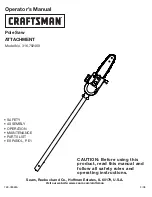
7
Lowes.com
sAFETY InFORmATIOn
• Crystalline silica from bricks, cement, and other masonry products.
• Arsenic and chromium from chemically treated lumber.
Your risk from these exposures varies, depending upon how often you do this type of work. To reduce
your exposure to these chemicals:
• Work in a well-ventilated area.
• Work with approved safety equipment, such as dust masks that are specially designed to filter out
microscopic particles.
• Avoid prolonged contact with dust from power sanding, sawing, grinding, drilling, and other
construction activities. Wear protective clothing and wash exposed areas with soap and water.
• Allowing dust to get into your mouth or eyes or to lie on the skin may promote the absorption of
harmful chemicals.
KICKbACK
Kickback is a sudden reaction to a pinched, bound, or misaligned saw blade, causing an uncontrolled
saw to lift up and out of the workpiece toward the operator.
When the blade is pinched or bound tightly by the kerf closing down, the blade stalls and the motor
reaction drives the unit rapidly back toward the operator.
If the blade becomes twisted or misaligned in the cut, the teeth at the back edge of the blade can dig
into the top surface of the wood, causing the blade to climb out of the kerf and jump back toward the
operator.
Kickback is the result of tool misuse and/or incorrect operating procedures or conditions and can be
avoided by taking the proper precautions as given below:
dAnGER:
Release the switch immediately if the blade binds or the saw stalls. Kickback could
cause loss of control of the saw. Loss of control can lead to serious personal injury.
To guard against kickback, avoid dangerous practices such as the following:
• Setting the blade depth incorrectly.
• Sawing into knots or nails in the workpiece.
• Twisting the blade while making a cut.
• Making a cut with a dull, gummed up, or improperly set blade.
• Supporting the workpiece incorrectly.
• Forcing a cut.
• Cutting warped or wet lumber.
• Operating the tool incorrectly or misusing the tool.
To reduce the chance of kickback, follow these safety practices:
• When the blade is binding, or when interrupting a cut for any reason, release the trigger and
hold the saw motionless in the material until the blade comes to a complete stop. Never attempt
to remove the saw from the workpiece or pull the saw backward while the blade is in motion or
kickback may occur. Investigate and take corrective actions to eliminate the cause of blade binding.
• When restarting a saw in the workpiece, center the saw blade in the kerf and check that saw teeth
are not engaged into the material. If the saw blade is binding, it may walk up or kickback from the
workpiece as the saw is restarted.






































